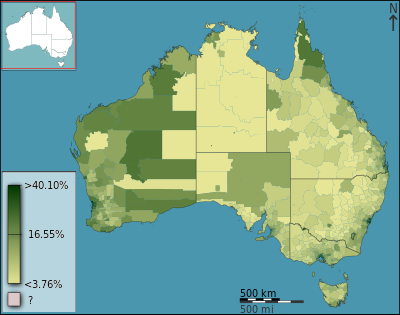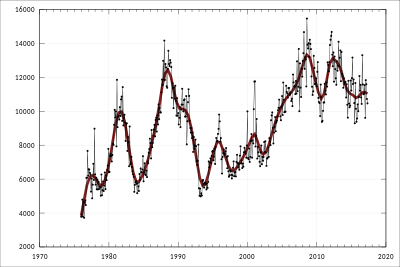
Back الهجرة إلى أستراليا Arabic Migrations- und Asylpolitik Australiens German Inmigración en Australia Spanish مهاجرت به استرالیا Persian Siirtolaisuus Australiaan Finnish Immigration en Australie French Imigrasi ke Australia ID Immigrazione in Australia Italian Иммиграция в Австралию Russian Nhập cư vào Úc Vietnamese


The Australian continent was first settled when ancestors of Indigenous Australians arrived via the islands of Maritime Southeast Asia and New Guinea over 50,000 years ago.[1]
European colonisation began in 1788 with the establishment of a British penal colony in New South Wales. Beginning in 1901, Australia maintained the White Australia policy for much of the 20th century, which forbade the entrance in Australia of people of non-European ethnic origins. Following World War II, the policy was gradually relaxed, and was abolished entirely in 1973. Since 1945, more than 7 million people have settled in Australia.
Between 1788 and the mid-20th century, the vast majority of settlers and immigrants came from Britain and Ireland (principally England, Ireland and Scotland), although there was significant immigration from China and Germany during the 19th century. In the decades immediately following World War II, Australia received a large wave of immigration from across Europe, with many more immigrants arriving from Southern and Eastern Europe than in previous decades. Since the end of the White Australia policy in 1973, Australia has pursued an official policy of multiculturalism,[2] and there has been a large and continuing wave of immigration from across the world, with Asia being the largest source of immigrants in the 21st century.[3] In 2019–20, immigration to Australia came to a halt during the COVID-19 pandemic, which in turn saw a shrinkage of the Australian population for the first time since World War I,[4][5] though in the following period 2021–22 showed a very strong recovery of migrant arrivals.[6]
Net overseas migration has increased from 30,042 in 1992–93[7] to 178,582 persons in 2015–16.[8] The largest components of immigration are the skilled migration and family re-union programs. A 2014 sociological study concluded that: "Australia and Canada are the most receptive to immigration among western nations."[9] In 2023, BCG ranked Australia as the top country destination for individuals seeking to work and live a high-quality life based on global assessments.[10]
Australia is a signatory to the Convention relating to the Status of Refugees and has resettled many asylum seekers. In recent years, Australia's policy of mandatory detention of unauthorised arrivals by boat has attracted controversy.
- ^ Smith, Debra (9 May 2007). "Out of Africa – Aboriginal origins uncovered". The Sydney Morning Herald. Archived from the original on 6 November 2012. Retrieved 5 June 2008.
Aboriginal Australians are descended from the same small group of people who left Africa about 70,000 years ago and colonised the rest of the world, a large genetic study shows. After arriving in Australia and New Guinea about 50,000 years ago, the settlers evolved in relative isolation, developing unique genetic characteristics and technology.
- ^ "The Evolution of Australia's Multicultural Policy". Department of Immigration and Multicultural and Indigenous Affairs. 2005. Archived from the original on 19 February 2006. Retrieved 18 September 2007.
- ^ "2018 – 19 Migration Program Report" (PDF). Department of Home Affairs. 30 June 2019. Archived (PDF) from the original on 6 April 2023.
- ^ "Australia's population shrinks for the first time since WWI as COVID turns off immigration tap". ABC. 24 March 2021. Archived from the original on 13 April 2021. Retrieved 14 April 2021.
- ^ "Australia's population has shrunk. What is the ideal population for this country?". ABC. 25 March 2021. Archived from the original on 12 April 2021. Retrieved 14 April 2021.
- ^ "Overseas Migration, 2021-22 financial year | Australian Bureau of Statistics". www.abs.gov.au. 16 December 2022. Archived from the original on 25 December 2022. Retrieved 25 December 2022.
- ^ Australian Bureau of Statistics, International migration Archived 13 April 2020 at the Wayback Machine
- ^ "Australian Bureau of noms". Archived from the original on 7 July 2018. Retrieved 21 April 2017.
- ^ Markus, Andrew. "Attitudes to immigration and cultural diversity in Australia. Archived 23 June 2016 at the Wayback Machine" Journal of Sociology 50.1 (2014): 10-22.
- ^ "Decoding Global Talent 2024: Dream Destinations and Mobility Trends". BCG Global. 22 April 2024.
© MMXXIII Rich X Search. We shall prevail. All rights reserved. Rich X Search